There were apparently no more French-language animated features besides Belvision’s up to 1970. During the 1970s, French animation exploded so much that this column covers the theatrical features from 1971 to 1975 only. These theatrical features are better-known by their directors than by their production studios.
This is also a good place to mention ASIFA and the French international animation festivals and awards. ASIFA (Association Internationale du Film d’Animation) was founded in 1960 in Annecy, France, along with the Festival Internationale du Film d’Animation d’Annecy. The festival basically takes over the whole town of Annecy, on the French side of the Swiss border, each June. The Annecy festival first gave its prizes to foreign animation, but French short films began winning in 1965 and features in 1991. French animation known outside of France is inextricably linked to the Annecy, and since 2011, the César awards. The older and more prestigious Cannes Film Festival has only rarely considered French animated films.
These features are arranged chronologically rather than alphabetically. It may make it harder to find a particular feature, but it gives a better picture of the development of French-language animation.
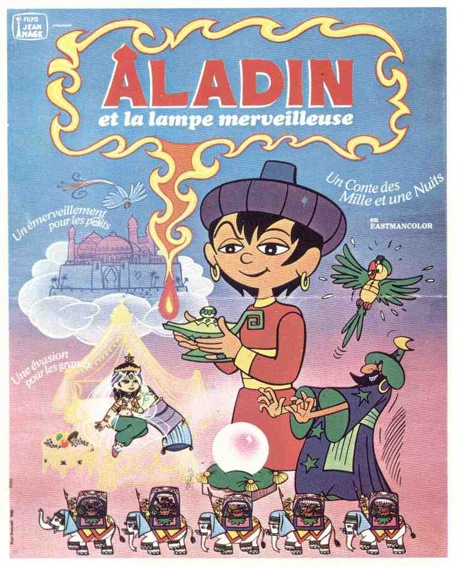
Aladin et la Lampe Merveilleuse (Aladdin and His Magic Lamp), directed by Jean Image. 71 minutes. January 28, 1970.
The standard Arabian Nights tale. An evil Persian Magician learns from his crystal ball of a magic lamp inhabited by a genie who will grant all wishes, hidden in a cave in a village near China; but it can only be retrieved by an innocent youth. The Magician travels to the village, pretends to be Aladdin’s long-lost uncle who will make him his heir, and leads Aladdin to the hidden cave. He gives Aladdin a magic ring to let him enter the cave and get the lamp. Aladdin does, but he does not trust the Magician and refuses to give him the lamp. The Magician, furious, seals the cave and leaves to find another youth after Aladdin has starved to death. Aladdin, about to die, accidentally rubs the lamp and the genie appears. Aladdin quickly wishes for his release from the cave, to become a wealthy youth, and to marry the Sultan’s beautiful daughter, Badroulboudour. When the Sultan sets seemingly impossible tasks for him, he orders the genie of the lamp to solve them. Just when it seems that Aladdin will live happily ever after, the Magician returns, guesses that Aladdin must have learned the secret of the lamp, and plots to steal the lamp from him. The movie is padded with side stories of the Magician’s adventures traveling from Persia through India to China, and songs about other “once upon a time” tales.
Pollux et le Chat Bleu (Dougal and the Blue Cat), directed by Serge Danot. 82 minutes. December 1970.
Stop-motion animation, based on the French-British five-minute TV series La Manège Enchanté (The Magic Roundabout), 1964 to 1977 in various versions. Due to the difficulty of translating the surrealistic French program (often described today as “David Lynch for pre-schoolers”), the British licensed the right to duplicate the puppets and write original stories. The TV program was for young children, although when the BBC moved it in 1967 from the evening to the afternoon when adults could not watch it, there were complaints from many adults who had been enjoying it.
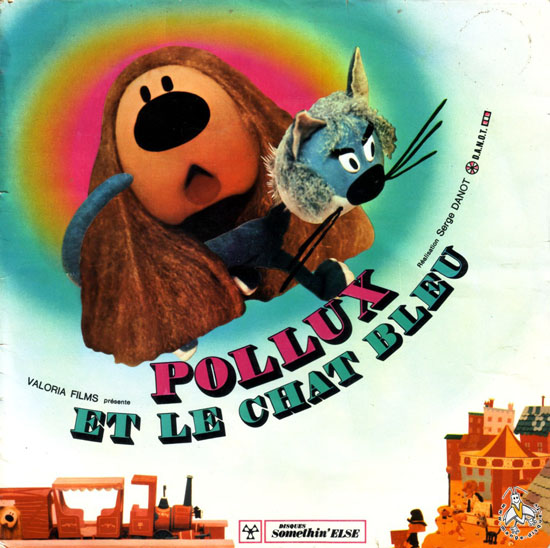
The Bois Joli (Happywood) is a village of lollipop trees and all kinds of candy, the home of Pollux (Dougal), the long-haired overly-British dog (a Lhasa Apso) who loves sweets. One day Pollux hears a mysterious blue voice in the abandoned treacle factory. The village’s magic roundabout (merry-go-round to Americans) brings a blue cat (Buxton) to the village. All the other characters like the blue cat except Pollux, who does not trust him. The cat hears about the blue voice in the treacle factory and goes there. The voice, belonging to the Blue Queen, offers to make him king if he can correctly identify the shades of seven blue doors. The cat does and becomes king with an army of blue men, which he uses to imprison everyone (except Pollux, who escapes) in the village. Pollux must free them; an ordeal that includes being tortured by sugar cubes.
Lucky Luke, directed by René Goscinny. 71 minutes. December 15, 1971.
This was covered in last week’s column. The famous cartoon-album series went on to have a long career in animated and live-action features, both on TV and in theatrical features, but this was the only one produced by Belvision Studios. (The movie was retitled in 1982 after Goscinny’s death, and is better-known today as Daisy Town.)
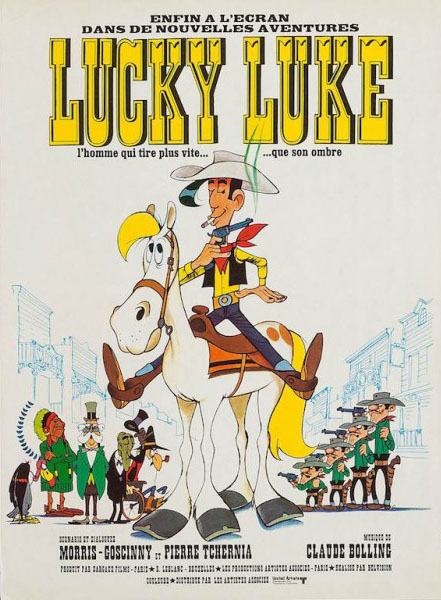
Tintin et le Lac aux Requins (Tintin and the Lake of Sharks), directed by Raymond Leblanc. 81 minutes. December 13, 1972.
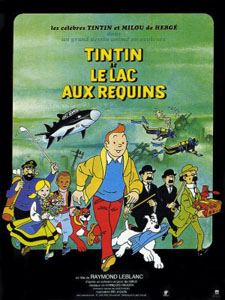 There had been Tintin animation since 1947, but Tintin et le Lac aux Requins was the first traditionally animated feature based upon an original story rather than an adaptation of one of Hergé’s novels. As usual for a movie based upon a long-running series, the script made sure that all of the regular characters from the different books were present.
There had been Tintin animation since 1947, but Tintin et le Lac aux Requins was the first traditionally animated feature based upon an original story rather than an adaptation of one of Hergé’s novels. As usual for a movie based upon a long-running series, the script made sure that all of the regular characters from the different books were present.
Tintin, his dog Milou (Snowy), and his best friend Captain Haddock are called to the Balkan country Syldavia to guard the famous scientist Professor Tryphon Tournesol (Cuthbert Calculus) who has rented a villa near an isolated lake to work on his newest invention. At the airport they meet their old friends, the lookalike detectives Dupond and Dupont (Thomson and Thompson), who are also working for the Professor. They all fly to meet him in a private plane. The plane appears to have engine trouble and the pilot leaves in the only parachute, but Tintin crash-lands it at the edge of a cliff. They are saved by two children, Niko and Nouchka, and their dog Gustav. Meanwhile, the pilot is seen reporting to his mysterious leader, “Mr. Big/King Shark”, that their plot to kill Tintin and his friends failed. The children take the group to the Prof.’s villa, but warn them that the Lake of Sharks is rumored to be cursed. At the villa, Tournesol demonstrates his invention: a camera that makes perfect duplicates of whatever it photographs. Tintin eventually learns that the villains are a gang, hidden in a flooded city at the lake bottom, who want to steal the camera and use it to make counterfeit rare paintings; and that King Shark is Tintin’s old enemy, Roberto Rastapopoulous. The adventure involves Tournesol’s shark-submarine, the opera singer Bianca Castafiore, and Syldavia’s rival Borduria; all from previous Tintin stories. Another Belvision production, and practically the studio’s last (although it is still active as a subcontractor).
Ô ou l’Invisible Enfant, directed by Raôul Duguay. 67 minutes. April 23, 1972.
“Une perle rare du cinémaque psychotronique québécois …” Not French but Québéçois and entirely in French, produced by the National Film Board of Canada. Duguay’s comment: “In 1969, the woman with whom I lived had a miscarriage. Attempting to transcend my pain with the loss of my child of flesh, I fantasized as to create a purely imaginary and spiritual child: O or the invisible child. As the wonder is the faculty that allows a bridge between dreams and reality, I started to believe that I was the child and Toulmond Toulmond was my child. I still need to believe it. I look at a child. He marvels at a flower. I look at modern man. He misses the pure freedom of her childhood.And I cry on his eyes. The child is invisible in him.” What it looks like to me: A beatnik (Duguay), “le plus fou de nos poètes”, takes off his clothes and cavorts nude through the Quebec countryside, and in only a fur coat through cities. It is a more psychedelic live-action feature with pixellation, drawing on film, and other camera tricks, switching between black-&-white, full color, and tinted black-&-white, than it is animation.
Apparently no theatrical poster exists because it was only shown in public three times before being released on video.
La Planète Sauvage (Fantastic Planet), directed by René Laloux. 72 minutes. May 10-25, 1973.
A French-Czechoslovak co-production, begun by Laloux and Roland Topor at the Jiri Trnka Studios in Prague, and moved to Paris after the 1968 Soviet invasion of Czechoslovakia. An adaptation of Stefan Wul’s s-f novel Oms en Série (Oms by the Dozen) with psychedelic art design by Topor. It was an international smash success, winning a special jury prize at the 1973 Cannes Film Festival (it was given a special premiere at Cannes six months before its general French release on December 6), and getting a general American theatrical release by Roger Corman on December 1. René Laloux (1929-2004) may be the internationally best-known French animation director, primarily for La Planète Sauvage.
In the far future, Earth has been destroyed. The only humans remaining are the Oms (hommes; men), living as wild animals on the distant planet Ygam, inhabited by the civilized 39-foot-tall blue Draags. Ter, an orphaned baby Om, is raised by Tiba, a young Draag girl, as a dumb pet. Ter is accidentally educated by Tiba’s telepathic teaching device. When he becomes an adult, Ter steals the device and escapes to the wild Oms. They use it and become educated just as the Draags prepare to exterminate them all as pests. The Oms revolt to be recognized as intelligent.
Joë Petit Boum-boum, directed by Jean Image. 60 minutes. April 19, 1973.
Basically a remake of Image’s 1950 Jeannot l’intrépede. Joe, a young boy, saves a beehive from two bullies and is invited by Queen Fleur de Miel 145 (Honey Flower 145) to visit it. Bzz, the Queen’s counselor, reduces Joe to bee size with a bee sting and becomes his friendly guide in the honeybee and ant worlds. Wou, a jealous drone, organizes the other drones to kidnap the Queen, but Joe saves her. After a big farewell party, Joe returns to the human world.
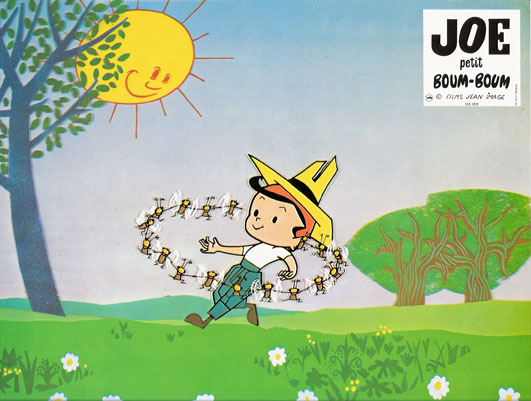
Les Trois Mousquetaires, directed by John Halas and Franco Cristofani. 68 minutes. 1974.
A British-French-Italian co-production, released as The Glorious Musketeers in Britain. Also titled D’Artagnan l’Intrépide in France. Dumas père’s famous story. The teenage d’Artagnan travels to Paris in 1625, joins the King’s Guard, and becomes the inseparable companion of their leading three musketeers: Athos, Porthos, and Aramis. When plotters steal the royal jewels to discredit Louis XIII’s queen, the now-four musketeers travel to England to retrieve them and save her reputation. The only release date that I can find is August 15, 1974 for the West German release.
Comme On Voudrait Nous Faire Croire que l’Atomique est un Champignon, Fleur de Napalm, directed by Philippe Bordier. 210 minutes. November 19, 1974.
An experimental film to be shown at international film festivals, consisting of one 20-meter loop projected over and over for 210 minutes. Premiered at the 9th SIGMA Festival in Bordeaux, November 18-December 8.
La Genèse (Genesis), directed by Pierre Albert. 60 minutes. January 20, 1975.
The first Book of the Bible, from God’s creation of the Earth to the story of Joseph.
Tarzoon, la Honte de la Jungle (Tarzoon, Shame of the Jungle), co-directed by Picha (Jean-Paul Walravens) and Boris Szulzinger. 85 minutes. September 4, 1975.
 Picha was an adult cartoonist and satirist, and Tarzoon, la Honte de la Jungle certainly combined both. In “Bush Country” in Deepest Africa, bald and multi-breasted Queen Bazonga plots to conquer the world, but is afraid that nobody will take a bald woman seriously. Charles of the Pits, her two-headed advisor, suggests that she get a scalp transplant, and she targets June, the mate of Tarzoon the Ape-Man, as the involuntary donor. Bazonga sends her penis soldiers to capture June, who is sleeping with Flicka, Tarzoon’s monkey pal… Wikipedia says that, “The film was the first foreign-animated film to receive both an X rating and wide distribution in the United States,” which puts the lie to the claim of the 1972 U.S. distribution of the Japanese Cleopatra, Queen of Sex getting an X-rating. Tarzoon, la Honte de la Jungle was a big hit with adult audiences in France. The Edgar Rice Burroughs estate tried to get it banned as an illegal plagiarism of Burroughs’ copyrighted Tarzan character and a demeaning of that character, but lost when a French judge ruled that it was a permissible parody. However, when the film was brought to the U.S. (released on September 14, 1979), the ERB estate caused so much trouble that the movie was retitled just Shame of the Jungle, the Ape-Man’s name was changed to Shame (the American voice actors included John Belushi, Bill Murray, and Johnny Weismuller, Jr.), and the movie was edited down to an R rating. Without the blatant parody of the Tarzan name, it failed in America.
Picha was an adult cartoonist and satirist, and Tarzoon, la Honte de la Jungle certainly combined both. In “Bush Country” in Deepest Africa, bald and multi-breasted Queen Bazonga plots to conquer the world, but is afraid that nobody will take a bald woman seriously. Charles of the Pits, her two-headed advisor, suggests that she get a scalp transplant, and she targets June, the mate of Tarzoon the Ape-Man, as the involuntary donor. Bazonga sends her penis soldiers to capture June, who is sleeping with Flicka, Tarzoon’s monkey pal… Wikipedia says that, “The film was the first foreign-animated film to receive both an X rating and wide distribution in the United States,” which puts the lie to the claim of the 1972 U.S. distribution of the Japanese Cleopatra, Queen of Sex getting an X-rating. Tarzoon, la Honte de la Jungle was a big hit with adult audiences in France. The Edgar Rice Burroughs estate tried to get it banned as an illegal plagiarism of Burroughs’ copyrighted Tarzan character and a demeaning of that character, but lost when a French judge ruled that it was a permissible parody. However, when the film was brought to the U.S. (released on September 14, 1979), the ERB estate caused so much trouble that the movie was retitled just Shame of the Jungle, the Ape-Man’s name was changed to Shame (the American voice actors included John Belushi, Bill Murray, and Johnny Weismuller, Jr.), and the movie was edited down to an R rating. Without the blatant parody of the Tarzan name, it failed in America.
Next week: 1976 – 1980.


 Fred Patten (1940-2018) was an internationally respected comics and animation historian. He has written about anime or comic books for publications ranging from Animation Magazine and Alter Ego to Starlog. He was a contributor to The Animated Movie Guide (2005), and is author of Watching Anime, Reading Manga (2004, Stone Bridge Press), a collection of his best essays, and Funny Animals and More (2014, Theme Park Press), based upon his early columns here on Cartoon Research. He passed away on November 12th, 2018.
Fred Patten (1940-2018) was an internationally respected comics and animation historian. He has written about anime or comic books for publications ranging from Animation Magazine and Alter Ego to Starlog. He was a contributor to The Animated Movie Guide (2005), and is author of Watching Anime, Reading Manga (2004, Stone Bridge Press), a collection of his best essays, and Funny Animals and More (2014, Theme Park Press), based upon his early columns here on Cartoon Research. He passed away on November 12th, 2018.





































I have the UK Eureka Blu-ray/DVD combo of La Planète Sauvage. Highly recommended, probably the best the film has ever looked. It includes both the French and English audio as well as the entire Alain Goraguer soundtrack and 5 additional short films by René Laloux (only one, Les Escargots, is restored however).
The Blu-ray unfortunately is region B-locked. Playing it in a different region player will give you this rather tongue-in-cheek lock screen:
http://i.imgur.com/yrvv52J.jpg
Sad even have any of Rene’s films on DVD here besides Anchor Bay’s crappy release of Fantastic Planet years back.
-Actually “Tintin and the Lake of Sharks” was not Belvision`s last feature, after that they did “The Smurfs and the Magic Flute” and the live action/animation “Gulliver`s Travels”.
-“The Glorious Musketeers” is basically a British-Italian co-production, with artwork mainly done between these two countries (parts were also animated in former Yugoslavia and Spain). A correctly made but rather uninspired adaptation of Dumas’ classic, with no memorable gags or scenes. It’s hard to believe that this came from the same director who two decades before had directed the brilliant “Animal Farm”.
-“Joe Petit Boum-Boum” is actually a feature edited from Jean Image’s TV series from the early 60’s Les Aventures de Joe (13 x 5′ episodes). There were other two 13 x 5′ series starring Joe in which he respectively visits the kingdom of the ants and the kingdom of the flies, also both edited as features for home video release.
The Musketeers film turned up on local TV in the ’70s. It’s a mess, frankly; one wonders if it was conceived as the pilot for a juvenile series.
D’Artagnan has a comic sidekick owl who comes and goes, and in one bizarre digression seems to be flirting / negotiating with a pigeon of doubtful morals. The villainous Cardinal has a cat who spies and actually whispers reports to his master; the Cardinal also sports a superhero-like hypnotic ring which he only uses once early on. At least one musketeer fights a duel while carrying his horse on his back; the battles are all clumsily gagged up even when there are supposed to be real stakes and risks. At one point the musketeers stumble across actual warfare in the French countryside (totally unexplained and immediately forgotten) that has soldiers dropping dead in sequence as a joke. Near the end, D’Artagnan is reunited with Constance and his three comrades march off as the Spirit of ’76 — a reference that would make sense for European kids?
The DVD I found has video-effect English titles; guessing that came with home video release.
I see this film did show up over here on VHS back in the 80’s courtesy of Vestron Video’s “Children’s Video Library” label.
https://www.youtube.com/watch?v=JEHu3X9qTdU
(funny NTA would distribute this crap!)
Vestron also handled Jean Image’s Baron Munchausen films as well, but I’m sure we’ll get to those soon enough!
Thinking of René Laloux just now, it always fascinates me how often he tend to use certain countries of questionable political standings to make his features in. Apart from Fantastic Planet having started in Czechoslovakia, we also have Time Masters being produced by Pannonia Filmstudio in Hungary, or Gandahar being worked on by the studio SEK (also called the “April 26th Children’s Film Studio”) in North Korea (though the US “Light Years” release credits the crew as being from South Korea to be on the safe side).
Reminded myself of that one funky tune in “Shame of the Jungle” I could never get out of my head, I see a 45 was released of it.
https://www.youtube.com/watch?v=Q8UYH5aCUbs
It appears that the sole version of SHAME OF THE JUNGLE that exists nowadays is the one that runs 68 minutes long… its original runtime was 85 minutes (!) long, and the X-rated US version (apparently one that didn’t involve the SNL/Nat. Lampoon alumni) 79 minutes long.
I once rented a copy on VHS back in the 90’s that seemed to have been taken from a rather damaged film print that had certain words seen on books or signs (though I’m sure it was in English) blocked out with a Sharpie and every time Tarzoon’s name was mentioned it was changed to “Noozart” by simply cutting out the original soundtrack whenever that name came out and simply splicing it in reverse. I suppose the 68 minute version was a fix to change the character’s name to “Shame” despite also editing out a lot of other stuff.
Another possible reason for the 68-minute R-rated print could be that International Harmony (distributors of the English version) were mostly unable to secure theaters willing to show the X-rated version, with the exception of a few in San Francisco.
Stop-motion animation, based on the French-British five-minute TV series La Manège Enchanté (The Magic Roundabout), 1964 to 1977 in various versions. Due to the difficulty of translating the surrealistic French program (often described today as “David Lynch for pre-schoolers”), the British licensed the right to duplicate the puppets and write original stories.
Technically, what the BBC did was simply went the same route “Samurai Pizza Cats” did, they threw out the original script and had Eric Thompson go and create one on his own by watching the action in the original episodes and coming up with his own brand of wit and characterization he gave these characters that differed greatly from the original source.
https://www.youtube.com/watch?v=CLdjHu3Egdg
While The Magic Roundabout in this state was never seen in the US (apart from the CGI effort “Doogal” that flopped over here a decade back), a version of the series, much closer to the French script, was aired once on Nickelodeon 30 years ago as one of many foreign productions that made up it’s “Pinwheel” series. Unlike the BBC handling of “La Manège Enchanté”, this one featured different voices actors for all the characters just like the French series originally had, rather than to go the storyteller route often seen in many British children’s programs. This is the Magic Roundabout I’m more familiar with (though it looks like they titled it “The Magic Carousel” for this version copyrighted to 1982).
http://www.dailymotion.com/video/xx8jt4_the-magic-carousel_fun